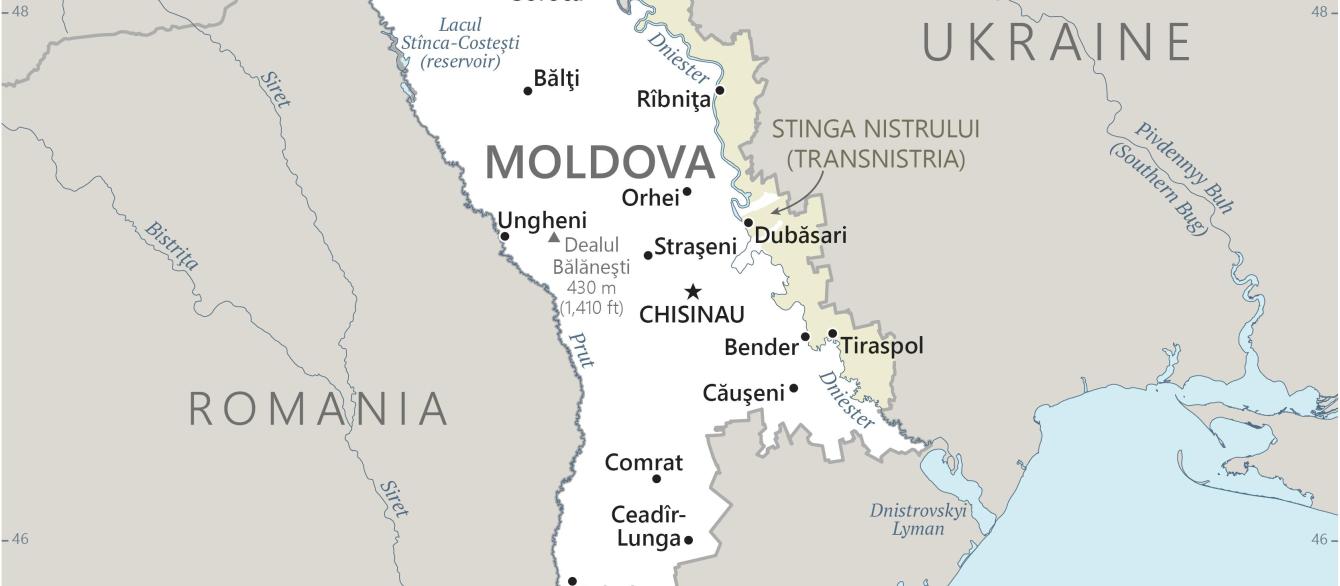This article was originally published by Good Authority and is shared under a CC BY-ND 4.0 DEED license.
Moldova has been making headlines recently for reasons both nefarious and, frankly, bizarre. In late 2023, a slew of Hollywood celebrities ranging from Lindsay Lohan to Brian Baumgartner (known for his role as Kevin in the popular comedy TV show "The Office") became inadvertently ensnared in a pro-Russian disinformation campaign on Cameo, an online video-sharing platform that helps celebrities connect with their fans. In a compilation of clips posted on TikTok, the stars — in garbled Russian — call for the overthrow of Moldova’s democratically elected, pro-European president Maia Sandu.
Moldova was back in the news in February 2024, as rumors circulated that the deputies of the separatist region of Transnistria might call for annexation by Russia. Ultimately, Transnistrian deputies instead made a vague appeal for Russian “protection.”
Russia’s reaction has been ambiguous. Commenting on the appeal, Russian foreign minister Sergei Lavrov accused the Moldovan government of “blocking everything Russian” — the same kind of rhetoric that Russia has used to justify its invasion of Ukraine. Although these comments raised concerns about Russia’s aims, a subsequent press conference by former Russian prime minister Dmitry Medvedev suggested that Russia’s territorial claims may stop at Transnistria’s border with Ukraine.
Moldova Is at a Pivotal Point
These recent events highlight the geopolitical vulnerability of this small country tucked between Ukraine and Romania. With E.U. aspirations of its own but lacking NATO protection, Moldova has long been the target of Russian destabilization efforts.
These efforts have only intensified since Russia’s full-scale invasion of Ukraine in February 2022. Initial fears that Moldova would be “next” have not panned out, as the Russian army remains bogged down in southeastern Ukraine. But Russia has resorted to other ways of influencing Moldovan politics in the run-up to the country’s 2024 presidential elections.
Sandwiched between east and west, Moldova now appears to be at a pivotal point in its political trajectory. Although Moldova has traditionally received far less attention than its eastern European neighbors, its fate is important — not just for Moldovans themselves, but for European security more broadly. Understanding Moldova’s current political challenges, we argue, requires a more careful examination of its history.
At the Crossroads of Empires
Over the past two centuries, the territories of the present-day Republic of Moldova were repeatedly shuffled between competing powers. Part of the medieval Principality of Moldova, the lands were incorporated into the Russian Empire in 1812, where they formed first the oblast (administrative region) and eventually the guberniya (governorate, or sub-division) of Bessarabia.
After World War I, Bessarabia (today’s right-bank Moldova) became part of the Kingdom of Romania, while Transnistria (a small slice of territory across the Dniester River) was carved out as an autonomous region within the Ukrainian Soviet Socialist Republic — a signal of the Soviets’ broader claims on the region. During the interwar period, Romania attempted to integrate Bessarabia into its modernization and nation-building project. The Transnistrian territory, meanwhile, experienced industrialization, collectivization, and Stalinist purges alongside the rest of the Soviet Ukraine. (For two comprehensive histories of Moldova, see Charles King’s The Moldovans and Rebecca Haynes’s Moldova: A History.)
In 1940, the Soviets fulfilled their imperial designs on Bessarabia, which they briefly occupied after signing the Molotov-Ribbentrop pact with Nazi Germany. Toward the end of World War II, the Soviets reasserted control over the territory and united Bessarabia and Transnistria into the Moldavian Soviet Socialist Republic. As in the other lands on the Soviet Union’s western flank — the Baltic countries, western Ukraine, and western Belarus — this process was accompanied by large-scale repression, including the deportations of tens of thousands of people to Siberia and Central Asia. Although discussing this repression was taboo during the Soviet period, new research reveals the long-lasting impact on Moldovan politics.
Russian Influence in Moldovan Domestic Politics
Since the collapse of the USSR, Moldova’s break with the Soviet past has been protracted. In the 1990s, the economic transition away from Soviet-era central planning produced crippling costs. The country’s high dependence on both Russian energy and Western bilateral and multilateral financial support severely circumscribed the government’s foreign policy options.
Many Moldovans remained nostalgic for the past, which fueled support for the country’s illiberal communist successor party. In 2001, Moldova became the first country in the region to vote an unreformed communist party back into office. The “Twitter Revolution” of 2009 eventually ousted the communists, after disputed parliamentary elections triggered massive protests and government repression. The coverage of these events by the country’s divided media further reinforced partisan divisions. These divisions, along with deep ethnolinguistic and foreign policy cleavages between pro-Russian and pro-European/Romanian camps, continue to dominate Moldovan politics.
Over the past decade, Moldova pursued a halting path toward European integration. Current President Maia Sandu is staunchly pro-European and in June 2022 Moldova received E.U. candidate status. But pro-Russian politicians remain influential. Although genuine support from the Moldovan population accounts for some of their political success, a number of high-profile Moldovan politicians enjoy significant Russian patronage.
Transnistria Has Become a Source of Leverage for Russia
Another source of Russian influence in Moldova is Transnistria. During the twilight of the Soviet period, nationalist protests erupted in Moldova, following many other Soviet republics. The Moldovan national movement elevated the voices of the Romanian-speaking majority, who had faced decades of Russian cultural domination. That left the leaders of the primarily Russian-speaking Transnistria region feeling threatened. Between 1990 and 1992, pro-independence Transnistria militia units — with assistance from Russian troops — fought against Moldovan forces. A 1992 ceasefire ended the fighting but “froze” the conflict, allowing state-like structures and patronage networks to develop in Transnistria to the point where many stakeholders had little reason to disrupt the status quo.
Russia has used the unresolved status of Transnistria as leverage in Moldovan politics. Russia maintains a small military presence in the region — although it should be noted that many “Russian” troops hold Moldovan passports as well. Moscow was also one of the parties in the “5+2 format” aimed at negotiating a resolution to the conflict between Chișinău and Tiraspol (the capitals of Moldova and Transnistria, respectively). Perhaps more importantly, Russia provides Transnistria with “free” natural gas, a major source of revenue for the territory.
For international audiences, Transnistria has become somewhat of a caricature. Articles portray it as a “mini-Russia,” with a Lenin statue standing proudly in front of the parliament building. Visitors must exchange Moldovan lei for “Pridnestrovian rubles” after crossing the border. And organized crime is a major problem in Transnistria. The Sheriff business empire dominates everything from supermarkets and gas stations to Transnistria’s popular soccer club, which represents Moldova in European competitions.
But for the most part, life in Transnistria is far more boring than these reports would suggest. For one thing, Transnistria maintains close ties with the rest of Moldova. Most residents are Moldovan citizens and many Transnistrian businesses export to European markets through Moldova. Since Russia’s full-scale invasion of Ukraine, in fact, Transnistria has become increasingly reliant on Moldova and the E.U., as financial support from Russia has waned and the war has disrupted revenues from smuggling.
Is Moldova Also a Russian Target?
The Russian invasion of Ukraine on Feb. 24, 2022, raised alarms in Moldova. Within weeks, the deputy commander of Russia’s Central Military District claimed Transnistria was part of the “second phase” of the war. Although those fears subsided as Russia failed to achieve its aims in Ukraine, Moldova’s fate remains closely linked to what happens across the border.
President Maia Sandu has strongly condemned Russian aggression in Ukraine, even as Moldova suffered a major energy crisis after Russia curtailed its natural gas supplies. Moldova has taken in over 100,000 Ukrainian refugees (a number equivalent to nearly 5% of Moldova’s population). Solidarity with Ukraine also has deep historical roots. News of Russian troops committing mass war crimes in Ukraine, including the deportation of thousands of children, prompted many Moldovans to recall the deportations of their relatives during the Soviet period.
Most Moldovans remain sympathetic to the plight of Ukrainian citizens. But public opinion is somewhat divided as to who is responsible for the war. A nationally representative public opinion survey from November 2022 showed that while 36% of Moldovans (a plurality) thought Ukraine was in the right, 22% said Russia was in the right; a further 23% said nobody was, and 18% said they didn’t know. Political sympathies for Russia during the war reflect a number of factors, from Russian propaganda to dissatisfaction with the Sandu government. Since June 2022, Moldova has blocked access to Russia’s main news agencies, but Russian disinformation still spreads via a number of channels — particularly online.
The Stakes Are High in Moldova’s Next Presidential Election
Russian meddling puts Moldova in a vulnerable position going into the country’s fall 2024 presidential election. Sandu has announced her candidacy for reelection as president and plans to hold a simultaneous referendum on European Union membership, staking her political fortunes on many Moldovans’ desire for European integration. But Sandu faces steep challenges going into the election. Russia will likely intensify its efforts to influence Moldovan politics by spreading provocative rumors, bankrolling corrupt politicians, and flooding the country with pro-Russian propaganda.
Moldovans are also eyeing the situation in Ukraine with concern. Ukraine’s brave resistance means that Russia lacks the resources to intervene militarily in Moldova. But faltering Western aid could spell disaster for Ukraine — and for Moldova. Thus, many see continued support for Ukraine as essential for the survival of both Ukraine and Moldova.

Moldova map showing major cities as well as parts of surrounding countries.








